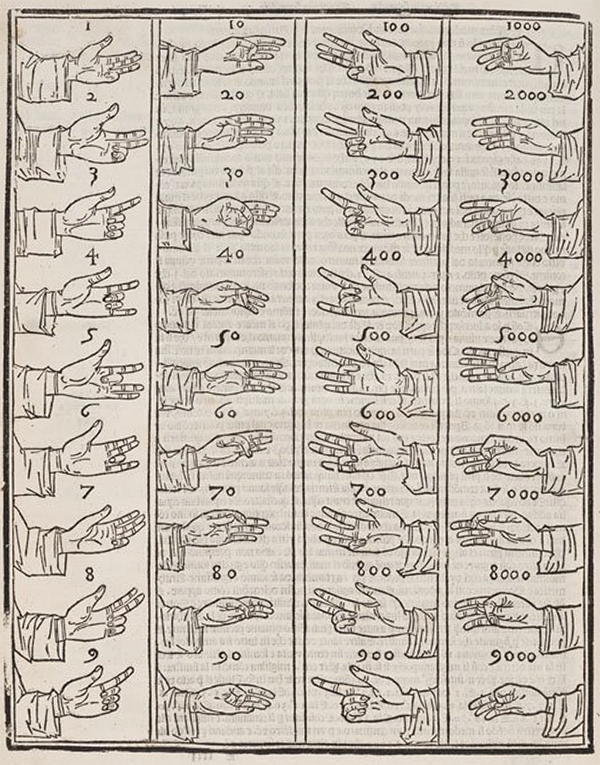- About MAA
- Membership
- MAA Publications
- Periodicals
- Blogs
- MAA Book Series
- MAA Press (an imprint of the AMS)
- MAA Notes
- MAA Reviews
- Mathematical Communication
- Information for Libraries
- Author Resources
- Advertise with MAA
- Meetings
- Competitions
- Programs
- Communities
- MAA Sections
- SIGMAA
- MAA Connect
- Students
- MAA Awards
- Awards Booklets
- Writing Awards
- Teaching Awards
- Service Awards
- Research Awards
- Lecture Awards
- Putnam Competition Individual and Team Winners
- D. E. Shaw Group AMC 8 Awards & Certificates
- Maryam Mirzakhani AMC 10 A Awards & Certificates
- Two Sigma AMC 10 B Awards & Certificates
- Jane Street AMC 12 A Awards & Certificates
- Akamai AMC 12 B Awards & Certificates
- High School Teachers
- News
You are here
An Arabic Finger-reckoning Rule Appropriated for Proofs in Algebra - Finger reckoning
Finger reckoning
Al-Karajī's "people seeking knowledge of calculation" practiced what we call finger-reckoning. In Arabic this method was known by various names, including "hand arithmetic", "open arithmetic", "aerial arithmetic", and "arithmetic of the Romans (i.e. Byzantines) and Arabs". (See Note 7, below.) Calculations were done mentally in base ten, and intermediate results were stored by positioning the fingers in particular ways. For example, Abū l-Wafāʾ (10th c.) explains that to multiply 46 by 28, one first finds 40 by 20 and 40 by 8, which together are 1120. This number is held on the fingers. Then the 6 is multiplied by 20 and by 8 to get 168, which is then added to the held 1120 to get the answer 1288. [Saidan 1971, 142.17] In the scheme described by ʿAlī ibn al-Maghribī in a fifteenth-century poem, units were stored by positioning the last three fingers on the right hand, tens with the right-hand thumb and index finger, hundreds with the left hand thumb and index finger, and thousands with the last three fingers on the left hand [Saidan 1968]. I know of no illustration from an Arabic source showing the positions of the fingers, but Luca Pacioli's famous Summa de Arithmetica has this nice engraving:

Figure 1. Finger positions in Luca Pacioli's 1494 Summa de Arithmetica. For additional images from Pacioli's Summa, see the Convergence article, "Mathematical Treasures - Pacioli's Summa".
In addition to laying out the steps for operating on whole numbers and fractions, books on finger reckoning present many shortcuts for particular situations. To multiply by 5 it is generally easier to take half and then multiply by 10, and there are similar shortcuts for multiplying or dividing by 25, 33\(1\over 3\), 125, etc. Or to multiply by 37 one can multiply a third of the number by 1, 10, and 100, and then add the results. One particular finger-reckoning rule for multiplying two numbers interests us for the unexpected use Ibn al-Bannāʾ made of it for proofs in algebra. This "squaring" rule is presented in many books, including Ibn al-Bannāʾ's own late thirteenth century Condensed [Book] on the Operations of Arithmetic (henceforth Condensed Book; see Note 8, below):
Another type is known as squaring. You take half of the sum of the two numbers and you square it. You subtract from the result a square of half of the difference between them. The remainder is the result of the multiplication. [Ibn al-Bannāʾ 1969, 51.7].
Ibn al-Bannāʾ gave no example to illustrate the rule, so I translate one from another book, the Completion of Arithmetic of al-Baghdādī (d. 1038):
For example, we want to multiply sixteen by twenty-four. We add them and we take half of the sum, which is twenty. We multiply it by itself, and we hold the outcome [with our fingers], which is four hundred. Then we take the difference between the two numbers to get eight. We multiply its half, which is four, by itself, to get sixteen. We subtract it from the four hundred that we held, leaving three hundred eighty-four, which is the required outcome. [al-Baghdādī 1985, 168.23]
We can express the rule algebraically as \(\left({1\over 2}(p+q)\right)^2-\left({1\over 2}|p-q|\right)^2=pq,\) but the application in finger-reckoning is somehow simpler, especially if the numbers are close together and half of their sum is easy to square. (Here and later I write \(|p-q|\) for the difference between two numbers. There was no concept of absolute value in medieval arithmetic because negative numbers were not acknowledged.)
Finger-reckoning was preferred by various professional groups, including government secretaries, merchants, and surveyors. One advantage of the method is that no writing was required. All calculations were worked out mentally with assistance from the fingers, and the results were expressed verbally. This is what al-Karajī meant by his phrase "by means of tongue and hand". Judging by the contents of books devoted to this kind of reckoning, practitioners would have often learned basic mensuration, but Euclid would have been out of reach.
Note 7. In Arabic, the names "hand arithmetic", "open arithmetic", "aerial arithmetic", and "arithmetic of the Romans and Arabs" are, respectively, ḥisāb al-yadd, ḥisāb al-maftūḥ, ḥisāb al-hawāʾī, and ḥisāb al-rūm wa-l-ʿarab.
Note 8. The Arabic title of the Condensed [Book] on the Operations of Arithmetic is Talkhīṣ aʿmāl al-ḥisāb. Incidentally, Ibn al-Bannāʾ copied this and some other rules word-for-word from Ibn al-Yāsamīn's Grafting of Opinions, without citing his source. Although plagiarism was frowned upon in Ibn al-Bannāʾ's time, it was not the crime then that it is now.
Jeffrey A. Oaks (University of Indianapolis), "An Arabic Finger-reckoning Rule Appropriated for Proofs in Algebra - Finger reckoning," Convergence (December 2018)




